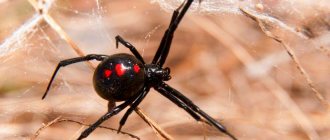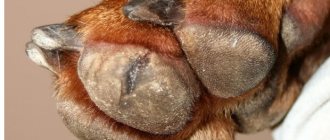Appearance
The muskrat is very similar in appearance to an ordinary rat, but is much larger in size. The weight of an adult muskrat usually ranges from 700 grams to 1.8 kg, most often from 1 to 1.5 kg. The muskrat's body length is usually from 23 to 36 cm. The muskrat has a fairly long tail, its length is 18-28 cm.
The muskrat's body is covered with thick fur, it consists of coarse guard hairs and soft undercoat. The muskrat's back color can be brown, dark brown or black. The fur on the belly is bluish-gray. The muskrat's tail is flatter on the sides, covered with small scales and sparse hairs.
The muskrat is well adapted to an aquatic lifestyle; for this it has a number of adaptations:
- Muskrat fur is thick and dense, does not allow water to pass through, and the muskrat constantly takes care of its fur, combing it and lubricating it with special fat for better water resistance. The thick and dense undercoat reliably protects the muskrat in the cold season.
- The muskrat's blood has a high content of hemoglobin, which creates a supply of oxygen when diving under water. The muskrat can stay under water for up to 17 minutes.
- The muskrat's body is able to reduce blood flow to the limbs and tail to maintain body temperature in cold water.
- The body shape and movements of the muskrat in the water are very similar to a torpedo. The muskrat is an excellent diver and swimmer, but on land it moves slowly and clumsily.
- The ears protrude slightly from the fur; they have a soft fold that covers them during diving.
- The eyes are small and set high.
- The muskrat's lips grow over the incisors, isolating them from the oral cavity, which allows muskrats to gnaw plants underwater without choking.
- The hind legs are equipped with swimming membranes, the front legs do not have them.
- The shape of the tail helps the muskrat in swimming; under water it acts as a rudder.
Population and species status
Muskrats are not on the verge of extinction; their population is large. There
are a large number of individuals living on the planet. The muskrat is common in many areas because it adapts well to the climate and is able to provide itself with food even in the most uncomfortable conditions. Humans contributed to the appearance of rodents on many continents by bringing them to these lands. It quickly became clear that the animal adapts well to both hot and cold climates.
The beast appeared in Europe in 1905. Several individuals of both sexes were released in the vicinity of Prague. The environmental conditions turned out to be so favorable for them that three decades later muskrats were regularly found in many European countries.
The rodent appeared in Russia in 1928, and within fifteen years it became one of the main suppliers of skins. Around the same time, the animal appeared in China and other Asian countries. There he also adapted well and began to increase the population.
The muskrat adapts perfectly to any conditions, the main thing is that there is a body of water nearby
Interesting fact : scientists have found that approximately once every 8 years the population of muskrats on the planet is greatly reduced, after which it begins to quickly replenish. What this is connected with is still unknown.
If the reservoir does not freeze in winter right down to the bottom, and a large number of plants grow next to it, muskrats are guaranteed to be able to settle here. Rodents reproduce quickly, which is why they are not on the verge of extinction. On the contrary, in some territories the number of individuals is so large that they fight for food and the right to establish a den.
Interesting: Interesting facts about the puma - photos and videos
A large number of individuals living near a reservoir has a positive effect on the local ecosystem. Thanks to the activities of muskrats, local areas are not covered with a large number of plants. The waters also contain much less silt. All this has a beneficial effect on the life of fish and other underwater creatures. Land predators living nearby have a stable food source in the form of new muskrats that regularly appear.
It has already been proven that if muskrats ever cease to exist, serious changes will begin in their places of residence, and not for the better. All types of animals living in the surrounding area will experience problems of different nature.
What does a muskrat eat?
The muskrat's main food is coastal and aquatic plants. The basis of the muskrat's nutritional diet are the following plants: • Calamus • Sedge • Cattail • Reed • Reed • Arrow leaf • Pondweed
In the spring, the muskrat feeds on the young stems and leaves of these plants, in the summer and autumn it eats mainly the basal parts and rhizomes, and in the winter it switches to feeding only on rhizomes.
In addition to plants, the muskrat constantly feeds on animal food, but its share in the diet is insignificant. The muskrat eats insects, frogs, mollusks, and small fish.
Nutritional Features
In nature, musk rats settle in areas with abundant vegetation, where the depth of the reservoir does not exceed 2 meters, because these are the most favorable conditions for the growth of the main type of food of the rodent. The muskrat feeds on reeds, horsetail, duckweed, cattails, calamus, reeds and sedges.
Rodents almost never eat fish; due to a lack of plant food, their diet may include shellfish, insects, and frogs.
When keeping at home, you need to keep the menu as close to natural as possible. Cereal porridges, eggshells, mixed feed, root vegetables, vegetables and fruits allow you to diversify your diet.
Muskrats eat almost continuously in the warm season. In this way, they accumulate fat for the winter so as not to die from cold and hunger. You can often see a muskrat, lying on its back on the surface of the water, gobbling up juicy reeds. That's why a rodent is a rodent, to constantly chew something!
Where does the muskrat live?
Initially, the muskrat was distributed in the reservoirs of North America, from where it was brought to Europe, after which it settled throughout the reservoirs of all Eurasia, right up to the Pacific Ocean.
The muskrat is distributed throughout Russia and neighboring countries.
The muskrat leads a semi-aquatic lifestyle, settling on the banks of large and small rivers, lakes and canals. Its favorite habitat is freshwater shallow swamps, the banks of which are densely covered with coastal vegetation.
Feeding wild muskrats
The muskrat is a valuable commercial object. Many hunters note that the population of the animal is decreasing every year and the reason for this is not hunting, but a reduction in the food supply. Some hunting farms interested in fur production are engaged in artificial cultivation of plants that the animals feed on and feed the animals.
We suggest you familiarize yourself with: Pheasant? Photo, description, habitat, food, enemies ✔
One of the most delicious types of plants - egg capsule - is bred in two ways.
The first is more labor-intensive and less effective. People manually collect the rhizomes of egg capsules from rivers and lakes, stack them on the shore, covering them with a tarpaulin. After some time, the egg capsule is planted in a pond where muskrats live, attaching planting material to the tips of split willow twigs. This allows you to secure the rhizomes in the pond.
The second method involves planting egg capsule seeds. The seed capsule is cut off along with the stem. The seeds are poured into a fishing trap and secured on a peg driven into the bottom of the reservoir. The top of the trap should protrude 15-20 cm above the water. As it ripens, the box opens and the seeds scatter, but do not sink to the bottom.
Another type of plant, water chestnut, is propagated and sown in a similar way. The fruits ripen in early autumn and are collected and placed in a fishing trap with burlap. About 50 - 55 kg of nut seeds are required per hectare of lake area. The large mass of seeds is due to the low percentage of germination. To prevent muskrats from eating the seeds, a special mesh of slats is installed on the bottom of the lake. These two simple methods have proven effective and have increased the number of animals in formerly deserted areas.
To do this, special feeders are installed near huts or feed pantries or food is scattered on the snow.
Muskrat huts and holes
Muskrats build two types of dwellings. Under the steep banks of lakes and rivers, muskrats dig long burrows; in a large family of muskrats, burrows can consist of ten rooms. The entrance to a muskrat's burrow is always under water.
In those places where it is not possible to build a hole for muskrats, they build another type of dwelling called a hut. The hut is built in the middle of a reservoir; it has a pyramidal shape, most often up to a meter high and the same width. Sometimes huts reach truly enormous sizes: up to two meters high and up to four meters wide.
The muskrat builds a hut from plant stems, lumps of dirt and peat, and branches of bushes. The entire muskrat family takes part in the construction of the hut, so construction proceeds very quickly. In addition to huts, muskrats build feeding huts, feeding tables and latrines.
The muskrat builds its nest in the center of this simple structure. In addition to the nesting room, there are several more chambers. The muskrat's house is dry and warm, and the entrance is securely hidden under water.
Male and female: main differences
Male and female muskrats
Outwardly, male muskrats do not differ from female muskrats. They all grow to the same size and gain the same mass. Both sexes have the same color coat. The only differences can be seen in the behavior of individuals after the appearance of offspring.
Which is logical, the female does not leave the den at first and takes care of the cubs. The responsibility of obtaining food and protecting the family falls on the shoulders of the male. But when the animals grow up, the roles change. The head of the pack is engaged in training the young, and the female devotes more time to replenishing supplies and maintaining the den in order.
Interesting: Do bumblebees make honey? Description, photo and video
Muskrat lifestyle
Leads an active lifestyle. The muskrat is always busy with something and has a lot to do. The main activity occurs after sunset and early in the morning. It migrates very quickly and actively, populating more and more new territories.
Muskrats live in large families, and each family has its own feeding area, which the males mark with their scent glands. Males drive strangers away from their area; only in winter do muskrats form large groups.
Lifestyle[edit | edit code ]
The muskrat leads a semi-aquatic lifestyle, settling along the banks of rivers, lakes, canals and, especially willingly, freshwater swamps. It prefers shallow (1-2 m deep), non-freezing reservoirs with banks covered with dense grassy vegetation.
Muskrats are active around the clock, but most often after sunset and early in the morning. They feed on coastal and aquatic plants - reeds, cattails, reeds, sedges, horsetails, arrowheads, and pondweeds. In spring, the muskrat feeds on young stems and leaves, in summer and autumn it eats root parts and rhizomes, and in winter only rhizomes. It also eats agricultural crops. The admixture of animal food (shellfish, frogs, fish) is constant, but insignificant [2].
For housing, the muskrat builds holes and huts. He digs a hole in a high bank. The length of the burrow passages varies, on steep banks 2-3 m, on flat banks - up to 10 m. The burrow opening is located under water and is not visible from the outside, and the nesting chamber is located above the water level. It happens that nesting chambers are located on two floors and connected by passages - this is provided in case of changes in the water level in the reservoir. Even in the most severe frosts, the temperature in the muskrat nesting chambers did not drop below 0 °C. On low, swampy shores, the muskrat builds above-water dwellings - huts up to 1-1.5 m high - from the stems of aquatic plants (reed, sedge, cattail), held together by silt. The entrance to them is also located under water. It also builds floating and open nests - feeding areas. In addition to living huts, muskrats also build storerooms where they store food for the winter.
Muskrats live in family groups that have their own feeding areas. The inguinal (perineal) glands of males secrete a musky secretion with which they mark their territory. They are intolerant of aliens, only forming groups during wintering. In spring, females drive their grown offspring away from the site; During overpopulation, cases of cannibalism are known. In spring and autumn, muskrats, who do not have their own families and feeding areas, make long migrations in search of free bodies of water.
Due to their abundance, muskrats play an important role in the diet of many predators, including elks, raccoons, otters, raccoon dogs, barn owls, harriers, alligators, and pike. Particularly great damage is caused to them by minks, which live in the same biotopes as muskrats and are able to penetrate their burrows through underwater passages. On land, muskrats are hunted by foxes, coyotes and stray dogs. Even crows and magpies attack young animals. Occasionally, muskrat holes and huts are destroyed by wolves, bears, and wild boars. Usually the muskrat escapes from enemies under water or in a hole, but in a hopeless situation it can desperately defend itself using its teeth and claws.
Slow on land, the muskrat swims well and dives well. It can survive without air for up to 12-17 minutes. Vision and smell are poorly developed; the animal mainly relies on hearing.
Muskrat breeding
The muskrat is extremely fertile; in northern latitudes, the female gives birth to two litters per year, in southern latitudes up to 4-5 litters per year.
Each litter contains 7-8 cubs. Sexual maturity of the female muskrat occurs between 7 and 12 months of life, pregnancy lasts about a month. Often, the female, while still nursing her cubs, may become pregnant again. The survival rate of the offspring is very high, since the male feeds the female for about two weeks, and she, in turn, spends all her time with the cubs. After a month, they become independent and begin to eat plant foods.
At birth, muskrat cubs weigh only about 20 grams, but already on the 10th day of their life they can swim, and on the 21st day of life they already begin to eat plant food. Muskrat cubs become completely independent by the 30th day of their life. Young muskrats spend the winter with their parents, and in the spring they disperse, exploring new territories.
Reproduction and care of offspring
As soon as the spring sun warms up, a crucial period begins in the life of the animals - reproduction. Mating games begin with males courting females. At this time, males are very excited, emit a loud squeak, and the production of musk by the glands increases. Mating occurs on land or in shallow water. This is followed by joint bathing and rest.
Pregnancy in females lasts about 26 days. The babies, and there can be up to 8 of them in a litter, are born blind, naked and toothless. Each weighs only about 20 g, so the babies require constant monitoring and care. Muskrats perform parental duties very well. There is always a lot of food in the nest - this is the merit of the male, and the offspring are always well-groomed through the efforts of the mother.
The muskrat's offspring grow quickly. The teeth appear already on the third day; at first they are white, then they turn brown. From the 13th day, the eyes open, and the baby is already trying to move independently. On the 18th day, he is already able to bite a possible enemy. A little earlier they begin to swim and try regular food, although they are still fed with mother’s milk. Within a month, growing muskrats begin to feed on their own. Such an animal is already quite capable of building its own home and storing food.
We suggest you familiarize yourself with: Hamster litter
In a suitable climate, a female can produce up to 3 litters per season. Yet the cubs exist together in the same family home until the mother forces them to leave. In nature, a furry rodent rarely lives beyond 4 years.
Muskrat fur
The muskrat is an important commercial fur species that provides a valuable, durable pelt. The beautiful and warm fur of the muskrat arouses interest among hunters in hunting muskrats. Muskrat fur is thick and has a dense undercoat, making products made from muskrat skins light and very warm.
After harvesting, muskrat skins are subject to careful processing; first they are well dried, and then they are degreased, straightened, finally dried and dressed.
Larger muskrat skins are used to make beautiful fur coats. Muskrat fur coats are very warm, soft, light and beautiful. Smaller skins are used to sew hats and other headwear. A muskrat hat is very pleasant to wear.
Fur products made from muskrat fur were very popular in Soviet times, especially muskrat hats. Nowadays, products made from muskrat fur are less popular.
Where does the muskrat live?
Due to its semi-aquatic lifestyle, the muskrat settles along the banks of ponds, rivers, freshwater lakes, and swamps. The rodent gives its preference to fresh water, but also lives in slightly brackish water bodies. A muskrat will never settle in a body of water where there is practically no aquatic or coastal vegetation. The animal will not live where the water freezes completely in winter. Depending on the territory where the animal lives, its home also differs and has different features.
- hole-tunnels with numerous ornate corridors;
- surface huts constructed from mud and vegetation;
- dwellings that combine the first two types of houses;
- houses that serve as temporary shelter.
If the shore of a reservoir is high, the rodent digs small holes in it, the entrance to which is under water. In the case when the reservoir is replete with vegetation, the muskrat builds huts in dense growth of reeds, sedges, cattails, and reeds. The special nesting room (chamber) in the burrows is always dry and does not come into contact with water.
The prudent animal builds an additional reserve chamber above the main one, in case the water level rises significantly. It turns out that the muskrat’s home is two-story. Inside there is a bedding made of moss and grass, which not only gives softness, but also protects the whole family from the cold.
The entrance to the burrow never freezes, because... located very deep underwater. Even in the deepest frosts, the temperature in the house does not drop below zero. The entire muskrat family waits out the most severe cold weather in its warm, soft, dry and well-kept home.
Muskrat meat
Muskrat meat is suitable for human consumption. In North America, the muskrat is even called the “water rabbit.” Many peoples of North America enjoy using muskrat meat to prepare many of their dishes.
Muskrat meat tastes like rabbit meat, but is fattier in composition. When eating muskrat meat, one should not forget that the muskrat is a carrier of more than 10 diseases, some of which are dangerous to humans.
Interesting facts about the animal
In the publication we reviewed important information about the muskrat.
Let us dwell separately on interesting facts about the animal:
- For a hunter, a musk rat is not only valuable and beautiful fur, but also tasty meat. Yes, the muskrat is edible and is a common food item in North America, where it is also called the “water rabbit.” The taste of the rodent really resembles rabbit meat, but in our country few people dare to try a piece.
- Muskrat cubs are born very small and blind, but develop quickly. Already on the 3rd day they begin to see, and by 10 they swim very well.
- Like any rodent, the musk rat is a carrier of many dangerous diseases. The most common are paratyphoid and tularemia. For these reasons, in many countries the muskrat is destroyed like rats.
- The animal is a pest. The countries of the East, where rice is grown, especially suffer from his gluttony. The muskrat settles so densely near water bodies that it can harm the biotope by destroying vegetation.
In general, the muskrat is a common animal for our latitudes. It has spread widely, as it easily takes root in almost any environmental and climatic conditions. The animal is smart, beautiful, worthy of existence, like all living things on this planet!
Muskrat hunting
Muskrat hunting is carried out in the autumn-winter period. This time of year is the lowest chance of encountering a pregnant female, so hunting at this time causes minimal damage to the muskrat population. In addition, in the autumn-winter period, muskrat skin is of maximum quality.
Muskrat hunting is carried out in three main ways:
• Hunting for muskrat with a gun • Hunting for muskrat with a trap • Hunting for muskrat using a trap
Hunting for muskrat with a gun
Hunting muskrats with a gun is less common than hunting muskrats with a trap. There are a number of reasons for this; firstly, when shooting muskrats with a gun, the skin of the animal is severely damaged and becomes unsuitable for further use. Secondly, such hunting is less productive; a hunter with traps usually sets a large number of traps and checks them regularly, as a result he will catch significantly more animals than a hunter with a gun.
In order to catch a muskrat with a gun, you need to find and examine a body of water in which a large number of muskrats live. It is convenient to explore a body of water late in the evening, standing on its shore, holding binoculars for hunting in your hands and carefully observing the surface of the water. If there are muskrats in this body of water, they will definitely show themselves by swimming on the surface of the body of water, leaving a trail on the water, in the form of divergent whiskers, or making splashes in the water.
The success of such a hunt depends on the accuracy of the hunter. The muskrat is most often shot while it is swimming through the water, so before shooting you need to have a good idea of how you will get the caught muskrat out of the water. In order to get a muskrat, you can either use a boat, or get the caught animal using a stick with a rope tied to it.
The only disadvantage of hunting muskrats with a gun is that you can damage the muskrat's skin, leaving a hole from a bullet or shot in the most visible place. The advantage of such a hunt will be that the largest and highest quality individuals will become trophies.
Muskrat behavior and nutrition
Muskrats live in groups that consist of married couples and their babies. In the spring, the young animals are expelled from the family, thereby reducing the size of the group. Young animals leave their acquired plots and look for new territories, which must have reservoirs.
These animals very carefully protect their land and water areas. Real massacres ensued with strangers, which often ended in the death of one of the rivals.
These rodents only live near water. They dig burrows on the banks of streams, lakes or ponds. The animals enter the hole through water. Muskrats dig holes with the help of their long and sharp claws. In addition to burrows, muskrats build above-water houses; they construct them when the area is very swampy and the banks are very low.
Muskrats are omnivores.
Muskrats use plant stems and branches as building material for their houses; the animals hold them together with mud and clay. Above-water houses can reach a height of 3 meters. Muskrats get into them, just like into a hole, from under the water. In the spring, when the reservoir overflows, the house can be washed away. Therefore, the construction of houses is carried out annually.
Muskrats are economic animals, but they do not stock up on food for the winter. If the winter is really hungry, they eat their houses from the inside. Muskrats are active at night, at dawn and dusk, and during the day they usually rest. If there is little food, then these rodents are active even at noon.
The diet consists mostly of plant foods - leaves, young shoots and roots of plants. If there are agricultural fields nearby, then rodents will happily eat cereals. Plant foods form 95% of the entire diet. The remaining 5% is allocated to animal food: crustaceans, frogs, fish, small turtles and freshwater mussels. During feeding, these animals move only along well-trodden paths.
Muskrat trap
Hunting for muskrat with a trap is the main way of catching this animal. To catch muskrats, traps No. 0 and No. 1 are used. The best time for such a hunt is from the beginning of September.
The trap is placed either at the entrance to the burrow or in the place where the muskrat feeds. You can arrange the feeding area yourself by adding vegetables and fruits. The trap does not need to be disguised; the animal is not afraid of unfamiliar objects.
In winter, it makes sense to set a muskrat trap inside the hut. The disadvantage of this type of hunting is that small individuals, whose skin is less valuable, are often caught in the trap.
Natural enemies of the muskrat
Since muskrats are found in large numbers in nature, they become prey for a large number of predators. Accordingly, the animal has enough natural enemies. These include dogs, foxes, raccoons, and coyotes.
Mink is the main enemy of muskrats
Interesting fact : minks pose the greatest danger to muskrats. They live in the same territories and often invade the dens of rodents.
Birds of prey are also not against feasting on the animal. Magpies, barn owls and crows can attack young individuals that are unable to fight back. In most cases, muskrats try to hide under water from being pursued by enemies. But even there they cannot feel safe. If a pike swims nearby, it is capable of attacking an individual swimming by.
Bears, wolves and wild boars can also be a nuisance to rodents. Despite the fact that they are not very interested in eating muskrats, they are capable of destroying their houses in search of food. Burrows are also under attack. The predator digs them out heavily, thereby making it easier for smaller enemies to get inside.
Interesting: How were dinosaur bones preserved? Description, diagram, video
Such a large number of potential enemies greatly strengthened the character of the muskrats. Rodents are always ready for a fight and are not afraid even of opponents who are several times larger than them. During a skirmish, the rodent uses its claws and teeth, and sometimes attacks the enemy first to gain an advantage.










